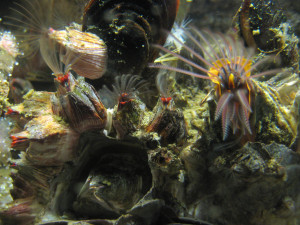Barnacles are arthropods contained in the class Crustacea along with lobsters, crabs and shrimp. They're believed to be one of the oldest surviving animals on Earth. There are more than 1,000 species of barnacles inhabiting brackish and saltwater environments worldwide. Although some barnacles are parasites, most are filter feeders. Filter-feeding barnacles are the type that engage in symbiotic relationships with whales.
Frizzle and her class set off on adventurous field trips on their magical bus. They discover new places, creatures, time periods, and several wonders of science. The magic school bus can transform into a plane, submarine, spaceship, and surfboard and travel to space, underwater, through an anthill, and inside the human body. While all of our teachers undergo the same thorough and on-going training, AVAC Swim School® is proud to offer diverse teaching styles. Please call us at 408.267.4032 for more information. Once you have chosen a class, you keep that spot.
What is Symbiosis?
In biological terms, symbiosis is broadly defined as a close, extended relationship between two or more members of different species that benefits at least one member. There are three types of symbiosis. In mutualism, both species benefit from the relationship. In parasitism, only one species benefits from the relationship and causes significant harm to the other. Commensalism, in which only one species benefits without causing significant harm to the other, is the type of symbiosis between barnacles and whales.
Cementing the Relationship

Barnacles begin their lives as free-swimming larvae, progressing through six larval stages. When they reach the last, or cyprid, stage, they settle onto the skin of a whale, where they complete their metamorphosis into juvenile barnacles. The juveniles -- tiny creatures resembling shrimp -- secrete cement that hardens into the hard, calcareous plates that surround them throughout their entire lives. As the cement plates meld together, the whale's skin is pulled into the spaces between the plates, permanently fusing the barnacles to the whale.


A Whale of a Ride
For the entirety of the barnacles' lives they'll exist as diminutive hitchhikers on the backs and bellies of whales. They derive two basic benefits from this commensalistic relationship. As filter feeders, they depend on the availability of plankton, which they filter into their bodies through feather-like appendages extended through holes in their shells. When the whales swim into plankton-rich waters to feed, so do the barnacles. They are consistently carried from feeding to feeding. Protection from predators is another benefit. Barnacles attached to stationary objects often fall prey to fish, sea worms, starfish and snails. However, the whale-riding barnacles enjoy a certain degree of protection from the mobility of their enormous bodyguards.
Avac Barnacles Baby Classes

The Whale's Perspective
For the most part, whale barnacles are harmless, even in astoundingly large numbers. For example, one humpback whale can host 1,000 pounds of barnacles without any problems. However, a few exceptions to the rules of commensalism can occur. Rbi software download. On some whales, too many barnacles can cause drag. Minor skin irritations or infections may arise. On the plus side, the barnacles can actually protect the whales, like a suit of armor. Gray whales have been known to roll over when under attack from other whales, presenting their enemies with a back covered in hard, spiny, immovable soldiers.
References (7)
Resources (2)

Barnacles begin their lives as free-swimming larvae, progressing through six larval stages. When they reach the last, or cyprid, stage, they settle onto the skin of a whale, where they complete their metamorphosis into juvenile barnacles. The juveniles -- tiny creatures resembling shrimp -- secrete cement that hardens into the hard, calcareous plates that surround them throughout their entire lives. As the cement plates meld together, the whale's skin is pulled into the spaces between the plates, permanently fusing the barnacles to the whale.
A Whale of a Ride
For the entirety of the barnacles' lives they'll exist as diminutive hitchhikers on the backs and bellies of whales. They derive two basic benefits from this commensalistic relationship. As filter feeders, they depend on the availability of plankton, which they filter into their bodies through feather-like appendages extended through holes in their shells. When the whales swim into plankton-rich waters to feed, so do the barnacles. They are consistently carried from feeding to feeding. Protection from predators is another benefit. Barnacles attached to stationary objects often fall prey to fish, sea worms, starfish and snails. However, the whale-riding barnacles enjoy a certain degree of protection from the mobility of their enormous bodyguards.
Avac Barnacles Baby Classes
The Whale's Perspective
For the most part, whale barnacles are harmless, even in astoundingly large numbers. For example, one humpback whale can host 1,000 pounds of barnacles without any problems. However, a few exceptions to the rules of commensalism can occur. Rbi software download. On some whales, too many barnacles can cause drag. Minor skin irritations or infections may arise. On the plus side, the barnacles can actually protect the whales, like a suit of armor. Gray whales have been known to roll over when under attack from other whales, presenting their enemies with a back covered in hard, spiny, immovable soldiers.
References (7)
Resources (2)
Photo Credits
Avac Barnacles Baby Classic
- Jupiterimages/Photos.com/Getty Images
